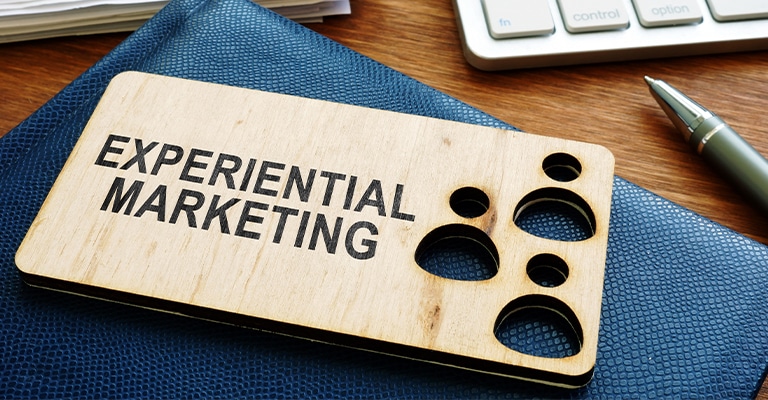Today’s marketing landscape is flooded with information, advertisements, and endless brand messages, making it increasingly difficult for businesses to stand out and connect with their target audience. Amidst this digital overload, a strategy has emerged, championing direct engagement and immersive experiences. This approach, known as experiential marketing, breaks the conventions of traditional advertising, inviting consumers not just to view but to actively participate in a brand’s narrative. Bridging the gap between brand and consumer interactively is changing how businesses market themselves, especially in bustling venues like trade shows. Dive in with us as we explore the intricacies of experiential marketing and its undeniable impact on the modern marketing scene.
What is Experiential Marketing?
Experiential marketing, often called “engagement marketing,” is an innovative strategy that immerses consumers in live, branded experiences. Instead of being passive recipients of a brand’s message, consumers get to actively engage, touch, feel, and connect with a brand’s ethos and products. It’s not merely about promoting a product or a service; it’s about allowing consumers to ‘experience’ the brand in real time, creating deeper emotional connections and memorable interactions.
The Importance of Experiential Marketing in Today’s Trade Show Industry
Traditional methods like brochures or videos aren’t enough in the competitive world of trade shows. Attendees crave genuine interactions. Experiential marketing meets this need by transforming booths into interactive hubs, promoting hands-on experiences. These captivating moments often get shared on social media, boosting the brand’s visibility.

Understanding the Basics of Experiential Marketing
Experiential marketing, often dubbed “engagement marketing,” transcends the norm of traditional advertising by inviting consumers not just to observe but to immerse themselves in a brand’s story actively. Consumers can interact instead of passively receiving a message, creating a tangible and memorable connection with the brand.
The Evolution of Experiential Marketing
Initially, marketing was predominantly about broadcasting a message to a broad audience, often through print, radio, and television. With the dawn of digital marketing and the rise of social media, there came a shift. Brands began seeking more personalized interactions, aiming to engage rather than merely inform.
Experiential marketing emerged as a solution, emphasizing two-way communication. It pivoted from the ‘tell and sell’ approach to ‘engage and bond.’ Whether through interactive pop-ups, VR experiences, or immersive events, experiential marketing has become a pivotal tool in creating lasting impressions and fostering brand loyalty.
Key Principles to Follow
- Consumer-Centric Approach: At its core, experiential marketing is about the consumer. Understand their needs, desires, and pain points to tailor resonating experiences.
- Authenticity: In an age of skepticism, authenticity is crucial. Brands should ensure their experiential campaigns are genuine and not just a gimmick.
- Interactivity: The more hands-on the experience, the deeper the engagement. Encourage participation, whether it’s through product trials, games, or interactive displays.
- Shareability: Craft experiences that people want to talk about and share. In the age of social media, a shareable moment can amplify a brand’s reach exponentially.
- Feedback Loop: Use these interactive experiences as an opportunity to gather feedback. It not only gauges the success of the campaign but also offers insights for future endeavors.
Experiential marketing is not just a fleeting trend but a paradigm shift. By adhering to its key principles, brands can harness their power to forge deeper, more meaningful relationships.

The Role of Displays in Experiential Marketing
Experiential marketing thrives on engagement, immersion, and memorable interactions. While the concept encompasses many elements, one cannot underestimate displays’ central role in this intricate dance of brand-consumer engagement. They act as visual anchors, guiding and enticing consumers into the brand’s narrative.
Displays as a Bridge to the Audience
Displays are the first touchpoint, the initial handshake between the brand and its audience. Think of displays as gateways; they either invite the audience in or keep them at bay. An effective display showcases a product or message and sets the tone for the following interaction. It’s the first step in drawing the audience into the experiential journey, creating anticipation and curiosity. Whether it’s an interactive touchscreen, a dynamic LED panel, or a tactile 3D setup, displays bridge the gap between the brand’s vision and the audience’s experience.
Enhancing Brand Recall through Effective Displays
The human brain is wired to remember experiences more vividly than static information. When designed creatively and intentionally, displays can leave lasting impressions that enhance brand recall. It’s not just about showcasing a product but creating a storyline around it, an experience the audience can relate to.
For instance, a cosmetic brand can use displays to show a new lipstick shade and allow users to try it on, blending technology with real-world interaction virtually. Or a tech company might employ holographic displays to provide a futuristic experience of their product.
An effective display isn’t just a visual treat; it’s a memory anchor. When consumers recall the experience, the brand automatically finds a place in that memory, strengthening brand association and loyalty.
In experiential marketing, displays are more than just visual aids. They are powerful tools that bridge the brand’s message with the audience’s experience and are pivotal in enhancing brand recall and forging deeper connections.

Steps to Incorporate Experiential Marketing into Your Display
Experiential marketing is all about engagement and creating lasting memories with your audience. Merging this approach with displays can be a game-changer, turning passive onlookers into active participants. Here’s a step-by-step guide to seamlessly blend experiential marketing into your display strategy:
Research Your Target Audience
Understanding your audience is paramount. Dive deep into their preferences, pain points, and aspirations. Conduct surveys, host focus groups, or even employ social media analytics to gain insights. The more you know about them, the better equipped you’ll be to design experiences that resonate.
Craft a Unique Brand Story
Your brand isn’t just a logo or a tagline; it’s a narrative. What’s the story you want to tell? Maybe it’s about sustainability, innovation, or community. Once you’ve honed in on your story, weave it into every element of your display. Let it guide the visuals, interactive elements, and booth design.
Choose Interactive Elements Carefully
Interaction is the heart of experiential marketing. But it’s essential to ensure relevance. Choose activities that align with your brand and cater to your audience. For instance, a sustainable brand might incorporate a virtual forest walkthrough, while a tech brand could opt for VR demonstrations.
Integrate Technology
In our digital age, technology, and experiential marketing go hand in hand. Whether it’s AR, VR, touch-sensitive screens, or AI chatbots, technology can elevate the interactive aspect of your display. However, remember to strike a balance. While tech can enhance the experience, it shouldn’t overshadow the core brand message.
Feedback Loops and Improvisation
Experiential marketing isn’t a one-size-fits-all strategy. It’s dynamic and evolving. Set up systems to gather real-time feedback from participants. Perhaps it’s through digital kiosks or feedback forms. Analyze this feedback to identify what’s working and what’s not. Being flexible and ready to improvise can often lead to even more engaging and memorable experiences.
Weaving experiential marketing into your display requires careful planning, a deep understanding of your audience, and the flexibility to adapt. When done right, it can transform your display from a visual entity to an immersive brand journey.

Challenges in Experiential Marketing
While powerful and innovative, experiential marketing doesn’t come without challenges. Designing immersive experiences that resonate with audiences requires a deep understanding and adept execution. Let’s delve into some of the prominent hurdles in this realm and ways to navigate them:
Overcoming Barriers
- Logistical Challenges: Organizing an experiential marketing campaign might involve coordinating multiple elements – technology, staff, venue, permits, and more. Addressing these logistical elements in advance, with contingency plans, ensures smoother execution.
- Budget Constraints: Crafting memorable experiences might sometimes mean stretching the budget. Brands must weigh the potential ROI against costs, finding innovative ways to engage without breaking the bank.
- Cultural and Regional Nuances: What works in one region or among one demographic might not translate seamlessly elsewhere. Brands must be sensitive to cultural differences, customizing experiences to resonate with diverse audiences.
The Balance Between Engagement and Overload
- Avoiding Sensory Overwhelm: You always risk overwhelming attendees to get them to engage. Too many stimuli – be it visual, auditory, or tactile – can confuse rather than captivate. Striking a balance is crucial. It’s about creating depth in the experience, not just breadth.
- Technology Integration: While integrating tech can elevate experiences, it should enhance and not dominate the narrative. The technology must serve the brand story and not the other way around.
- Feedback Saturation: While gathering feedback is essential, bombarding participants with too many questions or feedback loops can be counterproductive. Streamline the feedback process, focusing on quality insights over quantity.
While experiential marketing promises a goldmine of engagement and brand loyalty, navigating its challenges requires strategy, foresight, and adaptability. Balancing engagement without overwhelming the audience and tailoring experiences to overcome barriers can ensure a campaign’s success.

Measuring the Impact of Your Experiential Marketing
As with any marketing strategy, measuring the impact of your experiential campaigns is essential. This not only validates your investment but also provides insights for future endeavors. The assessment can be bifurcated into quantitative metrics and qualitative feedback, each providing unique perspectives on the campaign’s efficacy.
Quantitative Metrics
Attendance and Participation Rates: A basic yet vital metric. High attendance at your event or booth indicates initial interest and effective promotion.
- Engagement Metrics: Track the duration and type of interactions. For example, if you have a VR experience, how long did users engage with it?
- Sales and Conversion Rates: Post-event, monitor any uptick in sales or leads directly attributable to the experiential campaign.
- Social Media Traction: Monitor shares, mentions, likes, and hashtags related to your campaign. Given the shareable nature of experiential marketing, high social media engagement often correlates with a campaign’s success.
- Digital Analytics: If your experiential marketing has a digital component, such as an app or a website, use tools like Google Analytics to track user behavior and conversions.
Qualitative Feedback
- Participant Surveys: Post-event surveys can garner insights into what attendees liked or disliked. This direct feedback is invaluable for refining future strategies.
- Focus Groups: Organizing focus group discussions can delve deeper into attendees’ perceptions, feelings, and takeaways from the event.
- Social Media Sentiment Analysis: Beyond quantitative engagement, analyze the sentiment of social media mentions. Are people speaking positively about their experience? Or are there areas of criticism?
- Staff and Partner Feedback: Sometimes, your team or partners involved in the event can provide insights that might be missed otherwise. Their on-ground experience can shed light on operational aspects and attendee reactions.
Measuring the impact of experiential marketing isn’t just about numbers. It’s a blend of hard metrics and the more nuanced feedback from participants. Together, they paint a holistic picture of a campaign’s success and areas of improvement.

Closing Thoughts on Experiential Marketing
Experiential marketing stands out as a beacon in the ever-evolving landscape of brand strategies. It goes beyond traditional advertising, tapping into consumers’ emotional and sensory experiences. In a world dominated by digital interfaces and fleeting attention spans, offering tangible, memorable experiences can make a brand truly resonate with its audience.
However, like all powerful tools, it demands precision in execution. From understanding the target audience to integrating technology thoughtfully, from crafting compelling narratives to measuring the campaign’s impact meticulously—each step requires careful consideration. When done right, experiential marketing can transform casual onlookers into loyal brand advocates, crafting stories they carry with them and sharing them long after the experience has ended. In the end, isn’t that what all brands aspire for? A lasting impression and a story worth telling.




